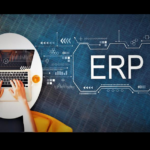
ERP stands for “Enterprise Resource Planning” and refers to a type of software or system used by a business to plan and manage daily activities such as supply chain, manufacturing, services, financials, and other processes. Enterprise Resource Planning software can be used to automate and simplify individual activities across a business or organization, such as accounting and procurement, project management, customer relationship management, risk management, compliance, business spend management, and supply chain operations through integration with a wide variety of platforms. learn more here.
Individual ERP applications can offer software as a service (SaaS), while a complete suite of ERP applications forms an ERP system that can be used to effectively communicate and bring together business processes to enable a flow of data between the applications, typically through common databases either on-site/on-premise or in the cloud.
ERPs connect every aspect of an enterprise. An ERP software system allows for better performance and project management that helps plan, budget, predict and accurately report on an organization’s financial health and processes.
The term “ERP” was first used in the 1990s by the Gartner Group, but enterprise resource planning software and systems have been used in the manufacturing industry for over 100 years and continue to evolve as the industry needs to change and grow.
The main purpose of an ERP system is to increase the organizational efficiency of an organization by managing and improving how company resources are utilized. Improving and/or reducing the number of resources necessary without sacrificing quality and performance are keys to effectively improving business growth and profitability.
ERP systems typically cover all aspects of business operations and commonly provide:
ERP software has the ability to collect and compare metrics across departments and provide a number of different reports based on roles or specific user preferences. The data collected makes finding and reporting on data faster and gives a complete view of business performance with complete insights on how resources are being spent.
ERP synchronizes reporting and automation by reducing the need to maintain separate databases and spreadsheets that would have to be manually merged to generate reports. This combined data collection and reporting offers valuable insight, such as where to cut costs and streamline processes, providing the information to make real-time business decisions.
Enterprise Resource Planning software is considered a type of “enterprise application”, which refers to software designed to satisfy the software needs of an organization and improve business performance. There are many different ERP systems available today that range greatly depending on the size, function, and needs of an organization. Types of ERP systems generally refer to deployment options and include cloud ERP, on-premise ERP, and hybrid ERP (some systems in the cloud and some on-premise).
Each ERP solution system is often tailored to support different aspects of a business, meet an organization’s business requirements, and have different methods of deployment.
In the past, “big business ERP” addressed large organizations that often deployed onsite/on-premise ERP solutions and had an abundance of resources to dedicate to IT and other support to analyze, customize, upgrade and deploy their software solutions.
The phrase “Small Business ERP” or “SME (small and medium-sized enterprise) ERP” is commonly referred to as ERP software systems with business management applications typically created to meet the specific needs of a small to mid-sized business.
Today, these phrases are used less frequently as the important factor is not company size but determining if the ERP system is effectively addressing current and future business requirements, no matter the size of the organization. It’s imperative that organizations consider and select ERP systems that eliminate the need for costly customizations, adapt to the rapid pace of business change, address future technologies and meet other identified requirements.
There are three main types of ERP systems that function with different deployment model options. The most common types of ERP systems include cloud ERP, on-premise ERP, and hybrid ERP.
Different ERP vendors support different deployment model options. Combinations of options often referred to as “hybrid” deployment may offer a combination of hosting and deployment services. These hybrid models can provide users with a flexible ERP solution and integrate benefits that may not have been available within the existing implementation.
Digital marketing enthusiast and industry professional in Digital technologies, Technology News, Mobile phones, software, gadgets with vast experience in the tech industry, I have a keen interest in technology, News breaking.